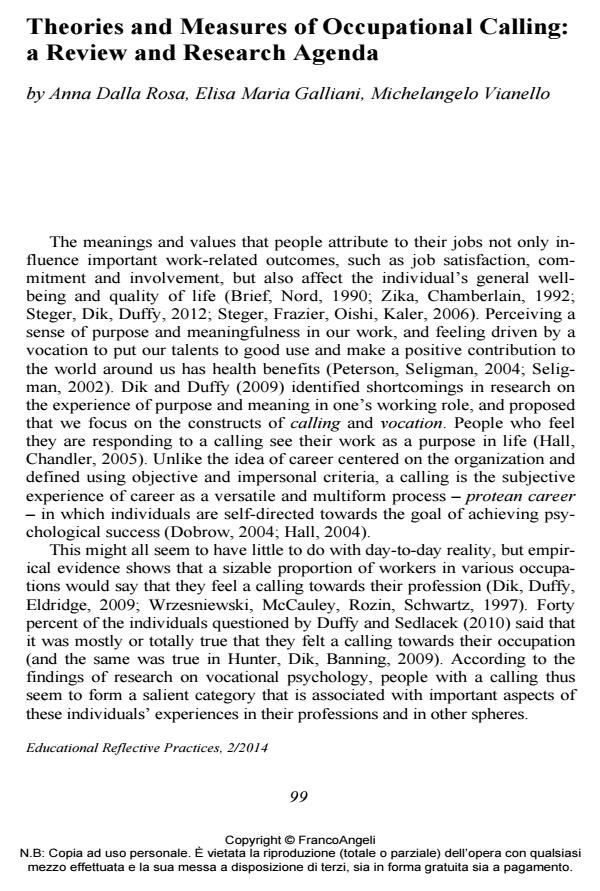Theories and Measures of Occupational Calling: a Review and Research Agenda
Titolo Rivista EDUCATIONAL REFLECTIVE PRACTICES
Autori/Curatori Anna Dalla Rosa, Elisa Maria Galliani, Michelangelo Vianello
Anno di pubblicazione 2015 Fascicolo 2014/2
Lingua Inglese Numero pagine 23 P. 99-121 Dimensione file 174 KB
DOI 10.3280/ERP2014-002007
Il DOI è il codice a barre della proprietà intellettuale: per saperne di più
clicca qui
Qui sotto puoi vedere in anteprima la prima pagina di questo articolo.
Se questo articolo ti interessa, lo puoi acquistare (e scaricare in formato pdf) seguendo le facili indicazioni per acquistare il download credit. Acquista Download Credits per scaricare questo Articolo in formato PDF

FrancoAngeli è membro della Publishers International Linking Association, Inc (PILA)associazione indipendente e non profit per facilitare (attraverso i servizi tecnologici implementati da CrossRef.org) l’accesso degli studiosi ai contenuti digitali nelle pubblicazioni professionali e scientifiche
People differ in the way they experience academic and professional careers, some may feel ‘called’ to a particular domain, while others may perceive their job as a simple mean to achieve higher goals. Research on career or vocational calling is still in its infancy, but it has so far observed some consistent results. Nonetheless, researchers have to deal with the lack of consensus about what constitutes a calling and how it should be measured. This paper addresses these needs by summarizing the main results of empirical research on calling. We integrate previous theoretical accounts in one single view that emphasizes commonalities across different theories and contributions. Next, we explore the academic and organizational outcomes of having a calling, highlighting those that showed more reliable empirical support. In this review, special attention will be devoted to the dynamics and individual development of calling. Finally, future research directions are discussed
- Employability & Competences Barbara Barbieri, pp.19 (ISBN:978-88-6453-671-2)
- Moderators of Career Calling and Job‐Search Behaviors Among Unemployed Individuals Anna Dalla Rosa, Michelangelo Vianello, Elisa Maria Galliani, Ryan D. Duffy, in The Career Development Quarterly /2020 pp.318
DOI: 10.1002/cdq.12239 - Linking Calling With Workaholism: Examining Obsessive and Harmonious Passion as Mediators and Moderators Anna Dalla Rosa, Michelangelo Vianello, in Journal of Career Assessment /2020 pp.589
DOI: 10.1177/1069072720909039 - Development and Validation of Teachers’ Sense of Calling Scale Puja Jain, Jasleen Kaur, in Management and Labour Studies /2021 pp.438
DOI: 10.1177/0258042X211018611 - Psychometric Properties and Measurement Invariance of a Short Form of the Unified Multidimensional Calling Scale (UMCS) Sophie Gerdel, Anna Dalla Rosa, Michelangelo Vianello, in European Journal of Psychological Assessment /2023 pp.408
DOI: 10.1027/1015-5759/a000722
Anna Dalla Rosa, Elisa Maria Galliani, Michelangelo Vianello, Theories and Measures of Occupational Calling: a Review and Research Agenda in "EDUCATIONAL REFLECTIVE PRACTICES" 2/2014, pp 99-121, DOI: 10.3280/ERP2014-002007